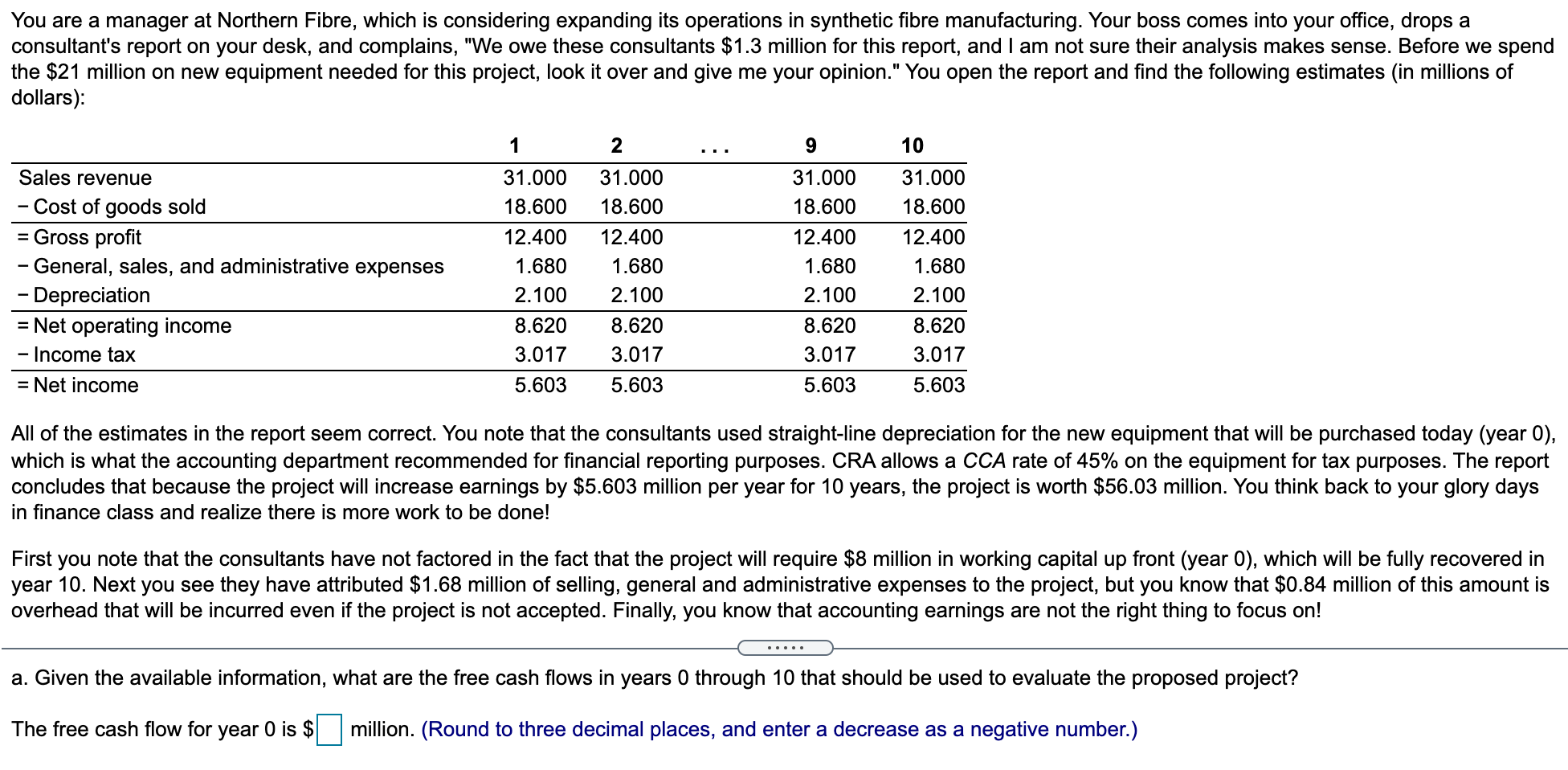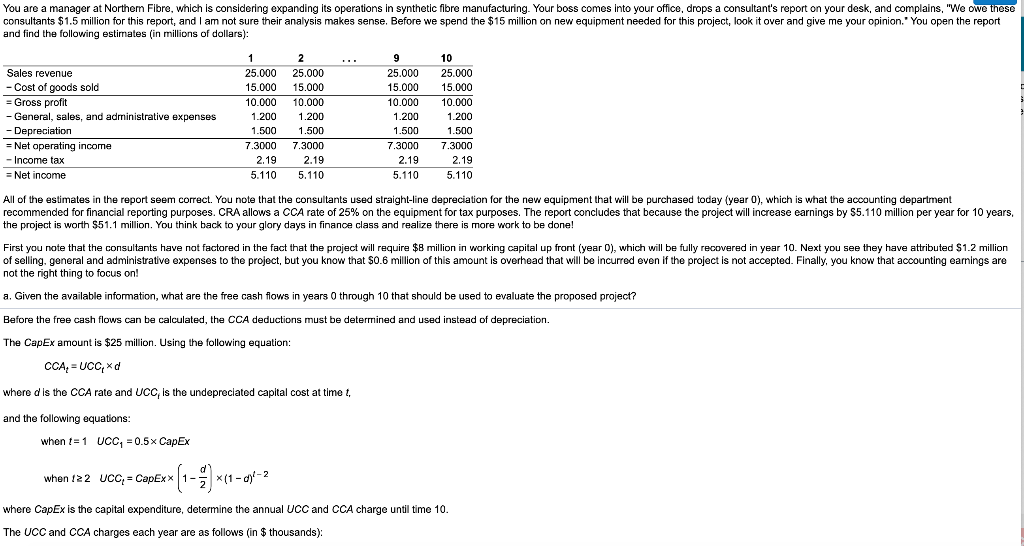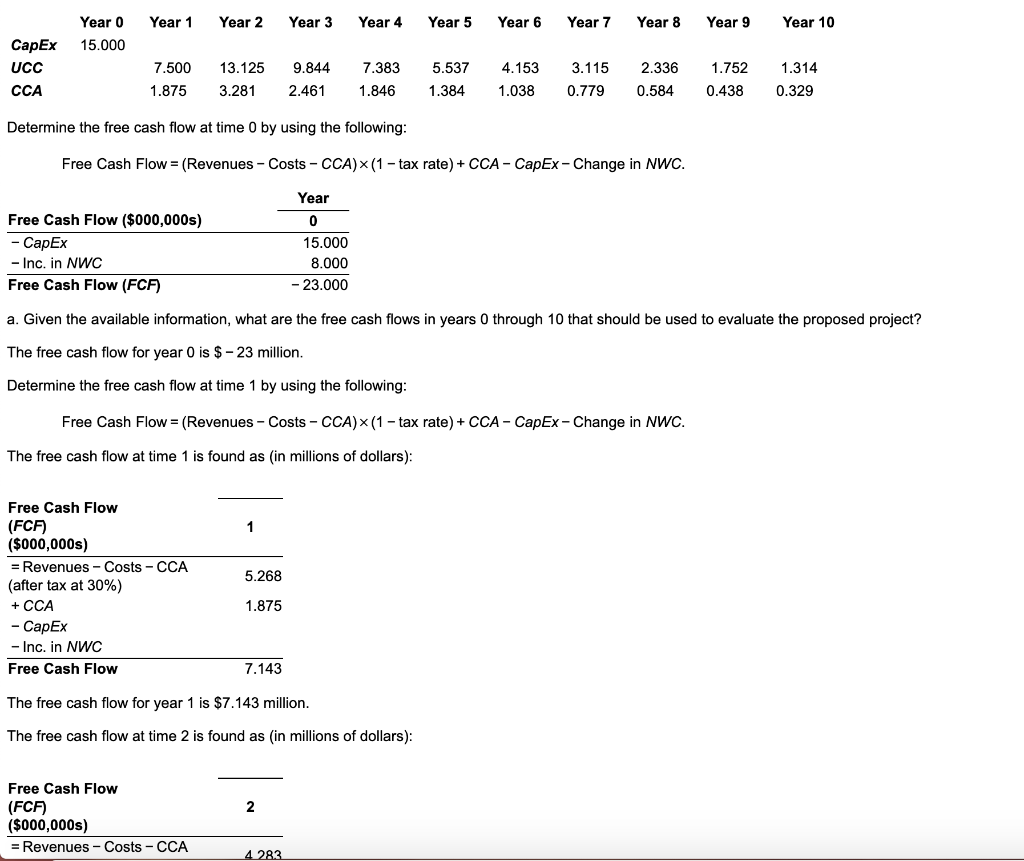Please help!

Question step by step example if needed. Not this question


You are a manager at Northern Fibre, which is considering expanding its operations in synthetic fibre manufacturing. Your boss comes into your office, drops a consultant's report on your desk, and complains, "We owe these consultants $1.3 million for this report, and I am not sure their analysis makes sense. Before we spend the $21 million on new equipment needed for this project, look it over and give me your opinion." You open the report and find the following estimates (in millions of dollars): 1 2 9 10 Sales revenue - Cost of goods sold = Gross profit - General, sales, and administrative expenses - Depreciation Net operating income - Income tax = Net income 31.000 18.600 12.400 1.680 2.100 8.620 3.017 31.000 18.600 12.400 1.680 2.100 8.620 3.017 5.603 31.000 18.600 12.400 1.680 2.100 8.620 3.017 5.603 31.000 18.600 12.400 1.680 2.100 8.620 3.017 5.603 = 5.603 All of the estimates in the report seem correct. You note that the consultants used straight-line depreciation for the new equipment that will be purchased today (year 0), which is what the accounting department recommended for financial reporting purposes. CRA allows a CCA rate of 45% on the equipment for tax purposes. The report concludes that because the project will increase earnings by $5.603 million per year for 10 years, the project is worth $56.03 million. You think back to your glory days in finance class and realize there is more work to be done! First you note that the consultants have not factored in the fact that the project will require $8 million in working capital up front (year o), which will be fully recovered in year 10. Next you see they have attributed $1.68 million of selling, general and administrative expenses to the project, but you know that $0.84 million of this amount is overhead that will be incurred even if the project is not accepted. Finally, you know that accounting earnings are not the right thing to focus on! a. Given the available information, what are the free cash flows in years 0 through 10 that should be used to evaluate the proposed project? The free cash flow for year 0 is $ million. (Round to three decimal places, and enter a decrease as a negative number.) You are a manager at Northem Fibre, which is considering expanding its operations in synthetic fibre manufacturing. Your boss comes into your office, drops a consultant's report on your desk, and complains, "We owe these consultants $1.5 million for this report, and I am not sure their analysis makes sense. Before we spend the $15 million on new equipment needed for this project, look it over and give me your opinion. You open the report and find the following estimates (in millions of dollars): 3 3 Sales revenue - Cost of goods sold = Gross profit - General, sales, and administrative expenses Depreciation = Net operating income - Income tax = Net income 1 25.000 15.000 10.000 1.200 1.500 7.3000 2.19 5.110 2 25.000 15.000 10.000 1.200 1.500 7.3000 2.19 5.110 9 25.000 15.000 10.000 1.200 1.500 7.3000 2.19 5.110 10 25.000 15.000 10.000 1.200 1.500 7.3000 2.19 5.110 All of the estimates in the report seem correct. You note that the consultants used straight-line depreciation for the new equipment that will be purchased today (year 0), which is what the accounting department recommended for financial reporting purposes. CRA allows a CCA rate of 25% on the equipment for tax purposes. The report concludes that because the project will increase earnings by $5.110 million per year for 10 years, the project is worth $51.1 million. You think back to your glory days in finance class and realize there is more work to be done! First you note that the consultants have not factored in the fact that the project will require $8 million in working capital up front (year 0), which will be fully recovered in year 10. Next you see they have attributed $1.2 million of selling, general and administrative expenses to the project, but you know that $0.6 million of this amount is overhead that will be incurred even if the project is not accepted. Finally, you know that accounting earnings are not the right thing to focus on! a. Given the available information, what are the free cash flows in years through 10 that should be used to evaluate the proposed project? Before the free cash flows can be calculated, the CCA deductions must be determined and used instead of depreciation. The CapEx amount is $25 million. Using the following equation: CCA, = UCC,d where d is the CCA rate and UCC, is the undepreciated capital cost at time t, and the following equations: when t= 1 UCC, = 0.5 x CapEx when 122 UCC, -CapExx [1- ] xt |x (1 dj-2 where CapEx is the capital expenditure, determine the annual UCC and CCA charge until time 10. The UCC and CCA charges each year are as follows (in $ thousands): Year 1 Year 2 Year 3 Year 4 Year 5 Year 6 Year 7 Year 8 Year 9 Year 10 Year 0 15.000 CapEx UCC CCA 7.500 9.844 13.125 3.281 7.383 1.846 5.537 1.384 4.153 1.038 3.115 0.779 2.336 0.584 1.752 0.438 1.314 0.329 1.875 2.461 Determine the free cash flow at time 0 by using the following: Free Cash Flow = (Revenues - Costs - CCA) (1 - tax rate) + CCA - CapEx-Change in NWC. Year Free Cash Flow ($000,000s) - CapEx - Inc. in NWC Free Cash Flow (FCF) 0 15.000 8.000 23.000 a. Given the available information, what are the free cash flows in years 0 through 10 that should be used to evaluate the proposed project? The free cash flow for year 0 is $-23 million. Determine the free cash flow at time 1 by using the following: Free Cash Flow = (Revenues - Costs - CCA)(1 - tax rate) + CCA - CapEx-Change in NWC. The free cash flow at time 1 is found as (in millions of dollars): 1 5.268 Free Cash Flow (FCA) ($000,000s) = Revenues - Costs - CCA (after tax at 30%) + CCA - CapEx - Inc. in NWC Free Cash Flow 1.875 7.143 The free cash flow for year 1 is $7.143 million. The free cash flow at time 2 is found as (in millions of dollars): 2 Free Cash Flow (FCF) ($000,000s) = Revenues - Costs - CCA 4 283









